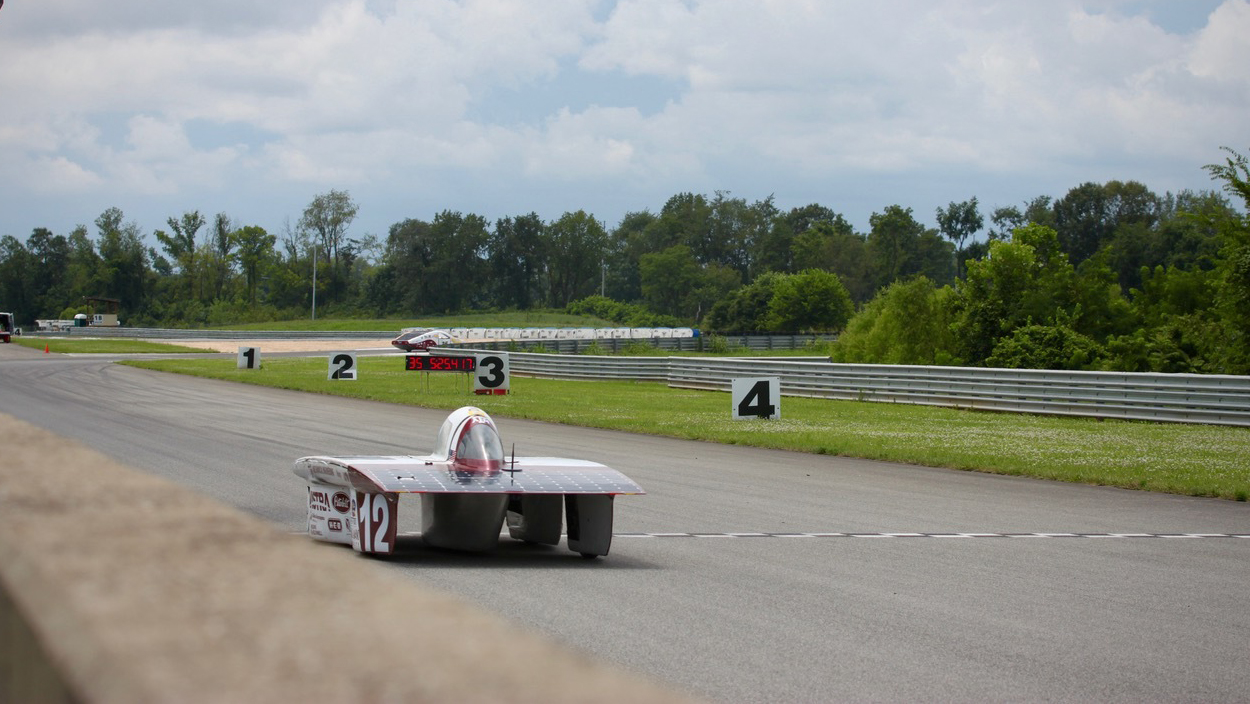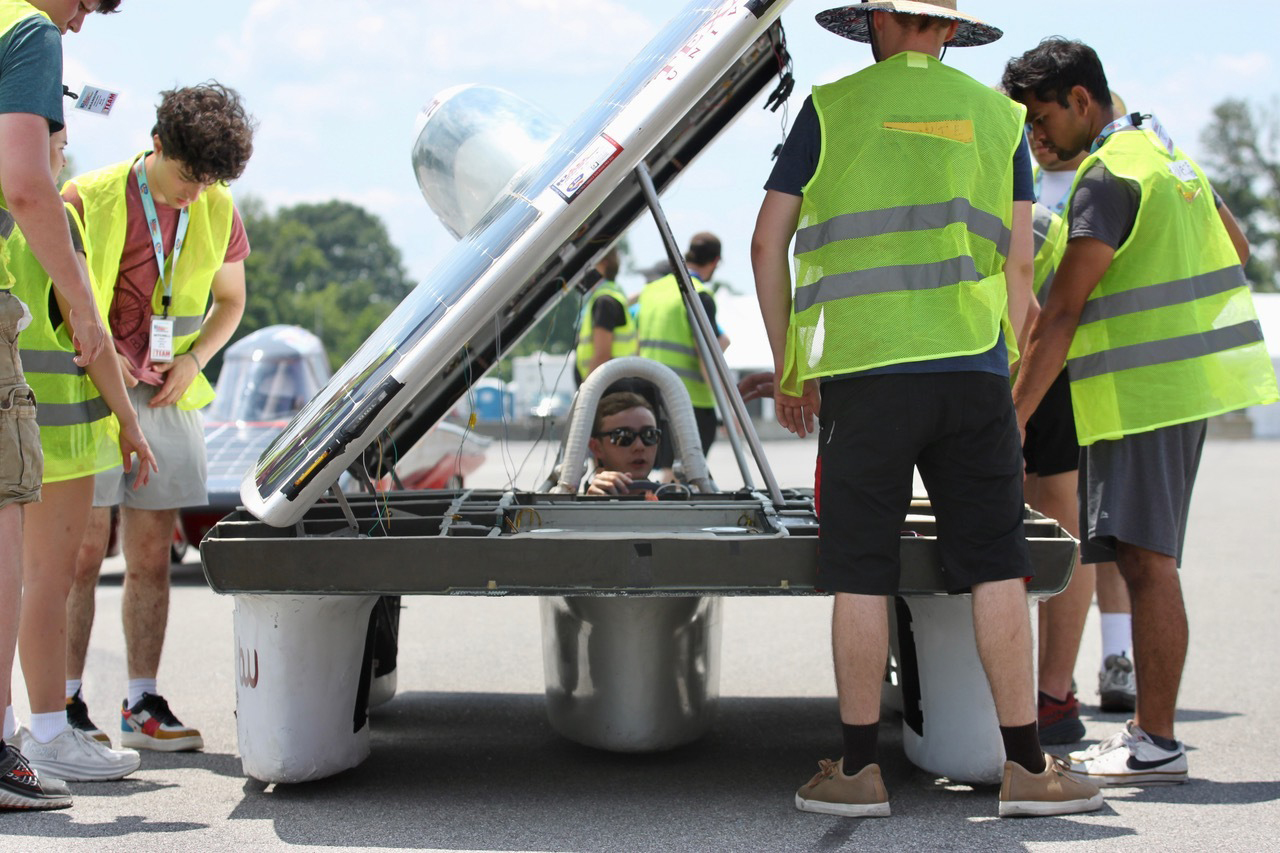
The Texas A&M University Solar Car Racing Team (Tamu Solar) spent three weeks racing across America in the Formula Sun Grand Prix (FSGP) and the American Solar Challenge (ASC). The team drove their single-occupant car, Duodecim, 1,500 to 2,000 miles across the United States, finishing 7th in their division and 11th overall. They were the only team in Texas to make it through each competition and the first rookie team to complete ASC since 2018.
More than 40 student teams nationwide participate in solar car racing, a collegiate design series put on by the Innovators Educational Foundation featuring two events, FSGP and ASC. Students spend two years building and developing sedan-sized, solar-powered race cars to compete in these events.
“You can only learn so much in a classroom. Being able to build a car from the ground up and then race on a racetrack or the open road is an incredible experience. You gain so much hands-on engineering experience,” said Eli Williams, a junior electrical engineering major. “The coolest part for me is thinking of an idea, prototyping it, and finally seeing it race.”
Williams was one of several drivers from the Department of Electrical and Computer Engineering racing eight hours a day to compete in FSGP, a closed-track race. During the competition, students learn to test the limits of solar cars, especially how to handle braking, acceleration and curves. This year, the race was held at the National Corvette Museum Motorsports Park in Bowling Green, Kentucky.
After successfully completing FSGP, Tamu Solar qualified to compete in ASC, a road race that partners with the National Park Service. Since the competition’s theme was “See America,” students followed a historic route, racing on roads such as Route 66, the Trail of Tears, the Lewis and Clark Trail, and the Oregon Trail. This year, the race started in Nashville, Tennessee, and ended in Casper, Wyoming. The team drove around 20 to 30 mph, and up to 65 mph through hilly country.
“One challenge we faced was on one-lane roads. When more than three cars piled up behind us, we had to pull over to let them pass, so we had to stop quite a bit for that,” Williams said. “Another challenge was semi-trucks coming the other way, which created wind gusts and made it harder to drive. As a driver, you have to stay alert.”

The team also faced challenges during the scrutineering process, when judges determine if your car is okay to drive. Since it was their first competition, the team spent up until the last minute fixing their car battery to align with certain regulations.
However, the scrutineering process also allowed Tamu Solar to meet teams from other schools, such as Michigan State University, Massachusetts Institute of Technology, and Stanford University. They made connections, checked out other cars, and helped each other fix technical issues in time to race.
“As a rookie team, the best thing for us was to see other people's designs. We were able to see what we can somehow implement into our car for the next design cycle,” Williams said. “Because now, we are in the process of making a new car from scratch.”
The team also received support from Aggies across the nation, from racing tips to donuts.
“One day, an Aggie and their daughter saw us from a baseball tournament, found out we were A&M and gave us some sports drinks. Another time, we were in Independence, Missouri, and the Aggie Club gave us breakfast and saw us off. That same day, we met a former driver for Tamu Solar from 1997 riding his motorcycle. He just saw us on the road and followed us all the way, 70 miles or so, to our final destination. He sat with us and talked about the old competitions and the things he used to do. That was pretty cool,” said Tyler Tomer, a junior computer engineering major.
Texas A&M's first solar team was founded in 1995 and disbanded in 2003 when their advisor retired. Ian Burress, a recent graduate with a master's in mechanical engineering, revived Tamu Solar in 2022 as a graduate student, and now, Dr. Robert S. Balog, a professor in the electrical and computer engineering department, is the team’s faculty advisor. Alumni from the 1995 solar team help the current team both financially and through mentorship.
Sponsors make building and racing cars possible for Tamu Solar. A member of the business team, Katherine Kristofek, a junior physics major, said raising funds for the team helped her learn about how to communicate with engineers and companies.
“I’ve learned so much about managing people and money, organizing events, all those sorts of things in a way that I don't think I would have gotten in a classroom,” Kristofek said. “Our finance and outreach sub teams are great opportunities for students to manage real money and see the impact on a team's success. Our first year was really difficult because for a while we didn't even have a car; we were in the design phase. We had to figure out how to market a car that didn't exist.”
Open to all majors, the Tamu Solar is made up of about 80 students, with majors ranging from nuclear engineering to sports management.
“You might be working on code, you might be designing a printed circuit board, you might be designing a battery or you might step up and be in leadership. Since it's a two-year cycle, if students decide to stay with the team the entire time, there's a whole range of projects they can work on,” said Tomer.